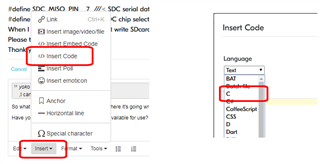Development Environment
S130 / SDK_12.3.0 Central Central NRF51 DONGLE
S130 / SDK_12.3.0 Central Peri NRF51822 + STM32F411
BUART_BAUDRATE_BAUDRATE_Baud115200
Hi, I am trying to implement BLE communication by sending STM32 data to the NRF.
I tested STM32 UART communication to NRF51822 by Terminal Program,'Teraterm'. and checked normal operation.
and, I tested nrf51822 and nrf51 dongle communication by Terminal Program,'Teraterm'. and checked normal operation.
However, sending data from STM32 to NRF51 DONGLE fails.
I think I made wrong code for NRF51822.
now, I am using Nrf_BLE_NUS_Services.
here is my code.
-------------------------------------------------------
uint8_t data_array[20];
data_array[0] = NRF_UART0->TXD;
....
for(;;)
{
ble_nus_string_send(&m_nus, data_array, sizeof(data_array));
nrf_delay_ms(10);
power_manage();
}
-------------------------------------------------------
It is the most basic code, but it does not make this part.
By the end of this week, code must be created to interact with STM32 and NRF51 DONGLE.
I'd appreciate your help.



